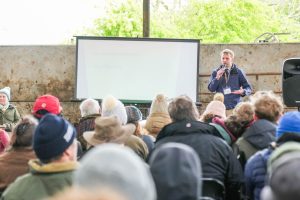Thoughts on business structures for the farm’s future
Phil Kirkpatrick, Partner and Head of Rural at Old Mill’s Exeter Office, has spent many years helping and advising farming clients on their business structures. Here Phil gives his thoughts on the tax landscape and the areas farmers should review in order to have the best chance in protecting the future of their farms. (As featured in the Farmers Guardian, October 2025)

10th October 2025
-
Phil Kirkpatrick See profile
Let's start with the present..
With economic pressures mounting and major tax reforms on the horizon, farming families can no longer afford to rely on tradition alone. A clear, well-structured business isn’t just good practice – it could be the key to protecting assets, reducing tax exposure, and securing the future of the farm for the next generation.
The farming landscape is shifting rapidly under financial strain and the threat of legislative change. Now more than ever, we must ask ourselves whether our business structures are genuinely fit for the future.
In my experience, the legal framework of a farm can make the difference between long-term survival and being forced to fold. There has probably never been a more important time to review your business structure. The right framework can shield you from tax exposure and give the next generation clarity and direction.
While some families have laid strong foundations, many existing plans are no longer fit for purpose. Others, who haven’t done anything at all, are now at serious risk.
Why Partnership structures still matter
For decades, farming families have relied on the time-honoured Partnership model: a framework that not only defines day-to-day roles but also allocates profits and responsibilities among family members. These structures can be excellent for intergenerational involvement, but they are not without shortcomings.
Partnerships are still one of the most positive arrangements for family farming businesses. They are a great way to bring members into the business. However, without a clear and coherent Partnership Agreement, things can go badly wrong.
The danger of complacency
Too often, a casual “we’ve always done it this way” approach leaves Partnerships vulnerable. When details aren’t ironed out at the outset, disputes can arise decades later.
Consider the situation where a long-term employee or family member, who’s been left in the dark about profit sharing since their teenage years, suddenly discovers they only have a 10% share despite decades of hard work. I’ve seen cases where someone has done almost all the work but received only a small percentage of profits because of an agreement made when they were 18. It’s simply not sustainable.
Business structures in farming go beyond splitting profits. They touch every element of the enterprise – from asset transfers and methods of incorporating new family members to navigating strict tax rules.
One of the most critical, yet often overlooked, aspects is formally documenting all terms regarding asset ownership and profit distribution. Poorly documented arrangements not only leave room for discord but can also trigger heavy tax liabilities. I’ve seen situations where unclear ownership of assets – whether farm cottages, machinery, or rented property – has led to unexpected capital gains tax (CGT) or stamp duty land tax (SDLT) penalties.
Without regular reviews, a Partnership agreement made years ago can quickly become outdated. If you don’t revisit it annually, ideally during your accounts meeting, you risk locking in arrangements that no longer reflect the contributions of those involved.
Anti-avoidance measures add another layer of complexity. Even with careful planning, transferring assets within a Partnership can trigger CGT or clash with Inheritance Tax rules such as the reservation of benefit. Unlimited reliefs that farming families have enjoyed in the past are probably going.
That’s why structures must be reviewed now, not next year. Without a proper structure, you could create tax problems by doing what you thought was the right thing.
Practical steps for a secure future
Based on my work with farming families, here are the key measures to strengthen and safeguard your business structure:
1 Establish a clear Partnership agreement
From the start, define ownership percentages, profit shares, roles, and dispute resolution mechanisms. A clear agreement avoids serious problems later.
2. Review agreements annually
As business dynamics change, so should your agreements. An annual review keeps the Partnership aligned with current contributions and responsibilities.
3. Plan asset transfers with expert advice
Transferring assets between family members can trigger Capital Gains Tax (CGT) or Stamp Duty Land Tax (SDLT). Always seek guidance to minimise risk.
4. Maximise tax relief opportunities
Understand which reliefs are available and ensure your structure allows you to claim them, especially for assets that might not obviously qualify.
5. Stay informed about policy developments
With potential caps on agricultural property relief looming, ongoing dialogue with advisers ensures your structure remains robust.
Let’s take an example
A husband, wife, and son are all in a farming Partnership, but the husband owns all the assets. On his death, if everything passes solely to the son, the wife’s agricultural property relief could go unused. This might lead to a potential inheritance tax bill of up to 20% on a million-pound asset. With better planning, such as redistributing ownership in advance, this risk could be mitigated.
It’s not enough to have a structure in place; it must be the right structure, updated regularly, and supported by open conversations within the family. The earlier these discussions happen, the better the outcome – for the farm, the finances, and the future.
If you want to discuss your current business structure, or any financial aspect of your farming business, contact Phil at philip.kirkpatrick@om.uk or 07929 234674.



